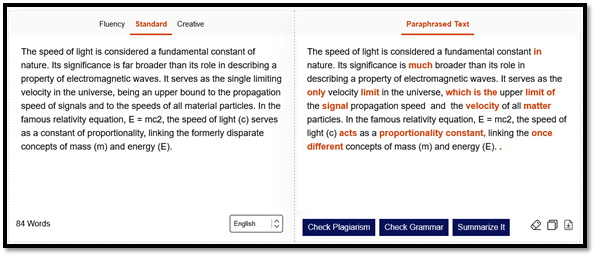Academic content is challenging and requires quality. So, what are the best paraphrasing tips to get there?
Academic content is one of the chief requirements of any student’s journey. While there are professional academic writers, too, students are the ones that worry the most about its aspects, such as paraphrasing.
So, what exactly is academic writing? What’s the significance of paraphrasing in it? And what are some tips for paraphrasing the best way? Let’s find out.

Defining Academic Writing
Academic writing is a type of formal writing that is used in academia. It is a form of research paper that can be written on any topic, but it has to follow certain guidelines and requirements. In order to write an academic essay, students must follow all the instructions given by their instructors.
They must use citations and references, use specific formatting styles such as APA or MLA, and write in the third person point of view. Academic essays are usually split into sections: an introduction, body paragraphs with evidence, and a conclusion.
But, since originality is a big part of it, it’s essential to avoid plagiarism or other sorts of duplicity—even accidental. Thus, Academic writing is all about integrity and content quality as it’s more about substance rather than the word count at the end of your assignment.
Importance Of Best Paraphrasing Tips In Academia
Paraphrasing is a technique that can be used by students to avoid plagiarism and also by professionals to make their work more readable. It is not just about changing the words but also changing the order of sentences or even adding some sentences.
The need for paraphrasing academic assignments is not just to save time but also to make sure that the content is accurate and gets the point across. There are many different ways of paraphrasing, but it all depends on what type of assignment you have and what your personal preference is.
There are two main types of paraphrasing: summarizing and synthesizing. What do they both mean?
- Summarizing means taking a few sentences from an article and then shortening them into one sentence.
- Synthesizing means you take an article word-for-word, change any words that need to be changed, and then turn it into a new sentence or paragraph.
While summarizing is also about shortening the text or providing a brief summary, summarizing in this context means using your own words to describe content from another author. Hence, the term paraphrasing is also employed in summing up content.
5 Best Paraphrasing Tips For Academic Writing
The best paraphrasing tips are the kinds that make it easier to do. In this list, we’ve tried to accommodate the best tips experts suggest to be most effective at paraphrasing. So without further ado, let’s get started.
1. Use Powerful Synonyms
As simple as it may sound, using alternative synonyms can strengthen your content much more. For instance, if you’re using a lacklustre word to describe something good, then it’s not going to have the same impact. Here’s an example:
“This is a good quality car.”
Nothing wrong with it; it’s as simple as one could describe it. But here’s an alternate version:
“This car is stellar & sleek.”
Can you notice the difference? The idea is the same, but the addition of powerful alternatives to “good” made it much more convincing. Therefore, find synonyms on google, or use the feature in MS Word.
2. Try Alternative & Simpler Phrases
Now, it’s not always about writing something powerful or outstanding in academic content. Sometimes, simpler sentences are much more impactful than any big words. For instance, describing an idea in layman’s terms is always good. Why is that?
- It shows your expertise.
- It shows your research.
If you’re describing something in simpler words, then it means you understand that perfectly. So, let’s take the speed of light, for instance. Here’s the definition of it:
“The speed of light is around 299,792,458 meters per second in the vacuum of space.”
In a scientific research fare, this would be an ideal sentence. However, for a common reader, you’d paraphrase it like this:
“The speed of light is capable of reaching the moon from the earth in 1.25 seconds.”
Notice how it gives the reader a perspective? Try to rewrite using simpler phrases or alternative terms to strengthen your content.
3. Change The Content Voice – Preferably Passive To Active
Changing the content voice from active to passive is one of the best paraphrasing techniques. While passive is acceptable in most cases, it’s better if your content is in an active voice. Here’s an example to give you a grasp of this idea:
Passive:
“The article is being written by John Doe.”
Active:
“John Doe is writing the article”
First off, the active voice uses much fewer words. Second, it’s much easier to read and understand.
4. Use A Paraphrasing tool – Various Content Modes
The best advice anyone can give you is to use a paraphrasing tool and be done with it. However, using a paraphrasing tool has its own perks and benefits. Nowadays, capable paraphrasing tools come with content tones or content modes. Such as these:

You can see how each one can help you get various types of content. So, pick a paraphrasing tool that offers these options, and try their various content tones, such as this:
Fluency:

Standard:

As you can see, both content tones help us achieve a significantly different type of text. So, try various modes before you think the paraphrased content is right for you.
5. Shift Word Forms: One of the Best Paraphrasing Tips
It might have been ages since you heard the terms first form, second form, third form, etc. But, we use them every day. That’s why it’s important to paraphrase by going back to these basics. Let’s see another example:
“The rain has poured down hard since this morning.”
Let’s try another example of paraphrasing:
“It’s been raining hard since this morning.”
See how the word form changed, but the meaning didn’t? That’s how you can use various forms of the same words to achieve better paraphrasing and, in most cases, better clarity too.
Conclusion
These are the five best tips you can get to rephrase your academic content. Paraphrasing is a responsibility; if not done correctly, it can cause plagiarism. In order to avoid that, it’s imperative to follow these tips from a professional writer.